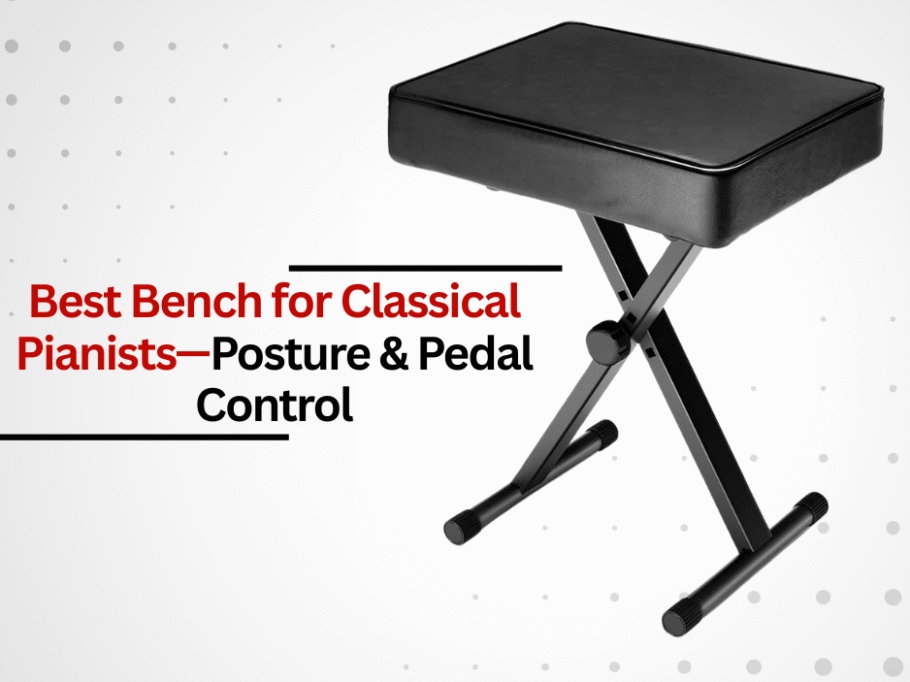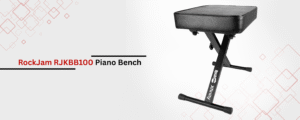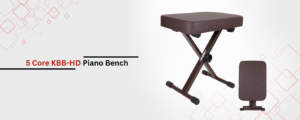For classical pianists, posture and pedal control are foundational elements that enhance technique and musical expression. The selection of classical piano benches must aid in correct body posture and effortless pedal movement. Most musicians, regardless of their skill, will struggle with balance, control, and endurance when facing time and nuanced performance without appropriate support. Whether for artistry, comfort, or both, finding the right bench serves as a supporting partner for the pianist’s musical journey.
Why Bench Matters For Classical Pianists
Supports Proper Posture:
Spinal alignment for a lengthy practice session or concert starts with the right height, cushioning and stability, which a bench provides, maintaining effortless tension. While a traditional seating position encourages tension; properly selected options aid in the relaxation portion of performance and allow the arms and hands to be free while moving through the keys.
Improving Pedal Technique:
Control wheel angles and seat height should work in tandem to make sure a pianist’s body captures the right pedal angle and distance. Ill-placed pedal resting height conjoined with unstable benches breeds leg strain, careless tension or unmeasured time, yielding poor tonal color and phrasing.
Aiding in Consistency:
Posture and pedal control fully aligned resonate in more expressive performances. A bench that offers dependable support eliminates distractions. This allows the musician to focus on the interpretations during the performance.
Top Picks for Classical Pianists for Piano Benches
For classical pianists, the selection of a bench impacts ease of access, comfort, and one’s performance on the piano. The listed benches below have the quality, style, and ergonomic support most classical performers seek.
RockJam RJKBB100 Piano Bench:
The RockJam RJKBB100 bench features a seat with thick foam padding on a lightweight X-frame. RockJam designed the bench for ease of travel, which makes it ideal for students and performers looking for comfort without added bulk.
Pros:
- Its slim and lightweight structure enhances portability.
- Its built-in support for higher weights makes it suitable for different users.
- Thick cushion reduces fatigue over extended play.
- The X-frame design provides sturdiness on uneven places.
Cons:
- Basic design lacks elegance for formal performances
- Very few color choices available
- The narrow seat restricts users for duet performances.
- Thin cushion makes it unsuitable for longer playing sessions.
5 Core KBB-HD Piano Bench:
The 5 Core KBB HD piano bench is designed for musicians who value comfort, durability, and versatility at an affordable price. It features a thick 3-inch cushioned vinyl seat with a padded faux leather covering to minimize fatigue during long sessions. The heavy-duty X-style steel frame provides excellent stability and supports up to 340 lbs, making it suitable for a wide range of users. Adjustable height settings from 14.5 to 20.5 inches ensure personalized ergonomics and accommodate various playing positions. Non-slip rubber end caps keep the bench securely in place and protect floors from scratches.
Pros:
- Adjustable height ranges from 14 to 20.5” inches, which accommodates a wide variety of player preferences.
- Rugged metal alloy X-frame ensures exceptional stability and long-term durability, even with frequent use.
- Impressive weight capacity of up to 340 lbs allows the bench to comfortably support a broad range of users and playing scenarios.
- The soft, high-density cushioning helps minimize fatigue during extended sessions.
- The most affordable option as compared to other models.
Cons:
- Overall, I liked the piano bench. I was expecting 3 days of delivery, but I received it after 4 days, which is negligible.
Upgrade your practice and performance setup—choose a piano bench that delivers ergonomic comfort and reliable support.
Find the ideal piano bench for your space and playing style—explore adjustable, cushioned options built for lasting use.
Roland RPB-400 Piano Bench:
Visual elegance paired Polished ebony wooden frame and luxuriously cushioned seat of the Roland RPB400 bench make it ideal for studio or formal performance. Designed for classical pianists, seamless integration of ergonomic functionality.
Pros:
- Exceptional seating comfort is ensured with ultra-thick cushions.
- The solid wooden frame provides long-term reliability and durability.
- Traditional aesthetic that suits the classic design.
- Best suited for formal recitals and studio settings.
Cons:
- Limited Flexibility.
- Less Portable due to its bulkier design.
- One of the most expensive benches as compared to other counterparts.
- Complex Assembly.
- Not built for cramped spaces due to its bulkier design.
Things to Consider when Selecting a Classical Piano Bench
Relate Piano Height with the Bench:
For the pianist’s arms, torso, and the keyboard to be optimally ergonomic, the bench must be at the right height to rest the elbows above the keyboard level and relaxed.
Ignore Style, Focus on Stability:
An eye-catching bench certainly matches a grand piano, but focus is critical. During a performance, a pedal’s sound might need to be controlled mid-centered through partial-blast, wobbling-dry, or uneven “Set” positions; any form of tilt is a major red flag.
Enhance Comfort Through High Performance:
Opting for a cushioned bench isn’t merely a sprinkling of magnificence; it lulls a pianist against fatigue and the exertion of physical effort, allowing for a high-octane focus through strenuous rehearsals and concerts.
Take Height Adjustability into Account:
Opting for a fixed-height bench is a traditional pastime; however, catering to height adjustability can be a boon for some venues, pianos, or specific repertoire encompassing arsenal mandates.
Conclusion
Picking the right classical piano bench has strategically influenced a pianist’s posture, performance, and precision in bench-for-pedal technique. A well-made bench encourages proper body alignment by providing balance and control while respecting the seating traditions of classical performers. Such pieces must also be instilled with comfort, stability, and durability because of their pivotal role as furniture for musical practice.
Brands like 5 Core, Roland, and RockJam have made it their mission to design musical benches that meet the expectations of classical pianists wherever they may be. We do not know what the future holds for us as it unfolds.





